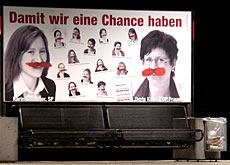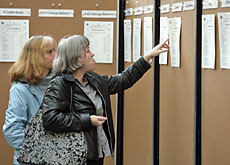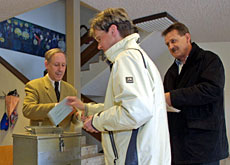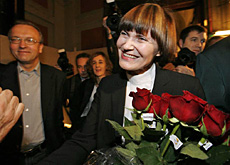Women hope a change of face will change minds

Swiss women politicians are getting angry – and some are even sporting bright red moustaches to draw attention to their complaints ahead of the federal elections.
Voters in canton Schwyz in central Switzerland are faced with campaign posters showing female candidates with hairy upper lips under the slogan “So that we have a chance.”
Men currently hold all six parliamentary seats for the canton, and the women have chosen irony in their battle to change this situation in next Sunday’s elections/to be held on October 21.
The problem is by no means confined to Schwyz.
Although more and more women are standing for election to the Swiss parliament, they remain under-represented, with only about a quarter of the seats.
Even worse from their point of view, statistics indicate that women are less likely to win a seat than men, especially in the House of Representatives, where in the last two elections they accounted for just over a third of candidates.
Nevertheless, the issue of women’s representation has been largely ignored in the run-up to the current elections, swept aside by the controversies surrounding the campaign of the rightwing Swiss People’s Party.
“This is my third campaign, and it’s the one where there has been the least focus on the issue of women,” said Géraldine Savary, a centre-left Social Democrat who is standing for re-election.
Consensus
Women across the political spectrum, apart from the People’s Party, agree.
The issue has never really caught on, according to Chiara Simoneschi-Cortesi, of the centre-right Christian Democrats, and president of the Federal Commission for Women’s Issues.
Within the two chambers of parliament, the difference between the parties is striking: the Social Democrats have 30 women parliamentarians out of 61, while the People’s Party have three out of 63.
The People’s Party is the only major party that believes openly that “there is no reason to treat women and men differently.”
The others have taken steps to support women who want to stand as candidates, and – at least to some extent – to push for equal numbers of men and women on their lists.

More
Senate
Public debate
But what is missing is a public debate on the issue.
“There needs to be debate on the subject before the elections if we want to see any change. Otherwise the ‘woman reflex’ is minimal or non-existent,” reckons Karin Schwiter, a researcher in gender studies.
As a Social Democrat candidate in Schwyz, Schwiter is one of the women involved in the moustache campaign. All the other major parties, except the People’s Party, are also taking part.
But raising awareness is one thing; the attitude of the electorate is something else.
“Studies show that women standing as Greens or Social Democrats in the large German-speaking metropolitan areas have more chances of getting elected than those standing for centre or rightwing parties in Ticino, for example,” Simoneschi-Cortesi told swissinfo.
“This can be explained arithmetically, but also culturally. If the electorate is not open to accepting female candidates, putting women on the lists won’t make much of a difference.”
swissinfo, based on an article in French by Carole Wälti

More
House of Representatives
House of Representatives (200 seats)
Of the 3,089 candidates, 1,088 are women (35.2 per cent). In 2003, there were 993 women.
Of the major parties, the Social Democrats and Greens have the highest proportion of women at (48 per cent). The centre-right Christian Democrats and Radicals have respectively 35.6 per cent and 25.7 per cent, while the People’s Party have 20.6 per cent.
Senate (46 seats)
Of the 130 candidates, 32 are women (24.6 per cent) In 2003 there were 26.
The Social Democrats have the highest proportion, at 42.8 per cent, followed by the Greens at 41.6. The Radicals have 21 per cent, the Christian Democrats 20.8, and the People’s Party none.
Swiss women did not get the vote at federal level until 1971. Switzerland was the last country in Europe apart from Liechtenstein to grant them this right.
According to the Interparliamentary Union, the country with the highest proportion of women in parliament is currently Rwanda.
Switzerland occupies 31st position in the world.
The first woman was elected to the Swiss cabinet in 1984, but she resigned after a scandal in 1989.
The first woman to hold Switzerland’s rotating presidency, in 1999, was Social Democrat Ruth Dreifuss, who was first elected to the government in 1993.
There are currently two women in the government: Social Democrat Micheline Calmy-Rey and Christian Democrat Doris Leuthard.

In compliance with the JTI standards
More: SWI swissinfo.ch certified by the Journalism Trust Initiative



You can find an overview of ongoing debates with our journalists here . Please join us!
If you want to start a conversation about a topic raised in this article or want to report factual errors, email us at english@swissinfo.ch.